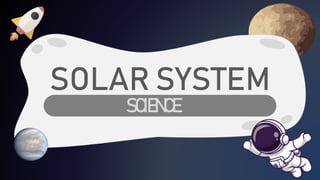
SOLAR SYSTEM
- 2. WHAT IS SOLAR SYSTEM? - The Solar System is the gravitationally bound system of the Sun and the objects that orbit it.
- 3. WHAT IS BEING STUDIED? - Understanding the planets and small bodies that inhabit our solar system help scientists answer questions about its formation, how it reached its current diverse state, how life evolved on Earth and possibly elsewhere in the solar system, and what characteristics of the solar system lead to the origins of life.
- 4. EXAMPLES OF PLANETS SUN MERCURY VENUS - The Sun is the star at the center of the Solar System. It is a massive, hot ball of plasma, inflated and heated by nuclear fusion reactions at its core. - Mercury is the first planet from the Sun and the smallest in the Solar System. It is a terrestrial planet with a heavily cratered surface due to overlapping impact events.. - Venus is the second planet from the Sun. It is a rocky planet with the densest atmosphere of all the rocky bodies in the Solar System, and the only one with a mass and size that is close to that of its orbital neighbour Earth.
- 5. EXAMPLES OF PLANETS EARTH MARS JUPITER - Earth is a terrestrial or inner planet consisting of a thin outer crust, an intermediate mantle, and a dense inner core. It has an atmosphere composed primarily of nitrogen and oxygen and is the only planet on which water in liquid form exists, covering more than 70 percent of its surface. - Mars is the fourth planet and the furthest terrestrial planet from the Sun. The reddish color of its surface is due to finely grained iron(III) oxide dust in the soil, giving it the nickname "the Red Planet". Mars's radius is second smallest among the planets in the Solar System at 3,389.5km. - Jupiter is the fifth planet from the Sun and the largest in the Solar System. It is a gas giant with a mass more than two and a half times that of all the other planets in the Solar System combined, and slightly less than one one-thousandth the mass of the Sun.
- 6. EXAMPLES OF PLANETS URANUS NEPTUNE SATURN - Saturn is the sixth planet from the Sun and the second-largest in the Solar System, after Jupiter. It is a gas giant with an average radius of about nine- and-a-half times that of Earth. It has only one-eighth the average density of Earth, but is over 95 times more massive. - Uranus is the seventh planet from the Sun and is a gaseous cyan ice giant. Most of the planet is made of water, ammonia, and methane in a supercritical phase of matter, which in astronomy is called 'ice' or volatiles. - Neptune is the eighth planet from the Sun and the farthest IAU-recognized planet in the Solar System. It is the fourth- largest planet in the Solar System by diameter, the third- most-massive planet, and the densest giant planet.
- 7. WHY IS IT IMPORTANT TO LEARN ABOUT IT? - The Solar System provides the only known example of a habitable planet, the only star we can observe close-up, and the only worlds we can visit with space probes. Solar System research is essential for understanding the origin and evolution of planets, along with the conditions necessary for life.